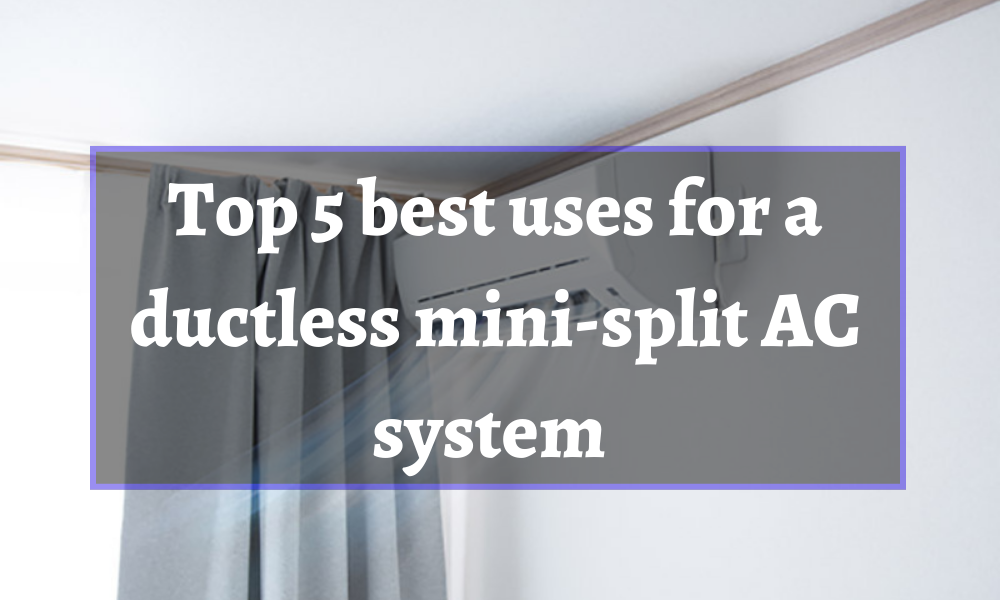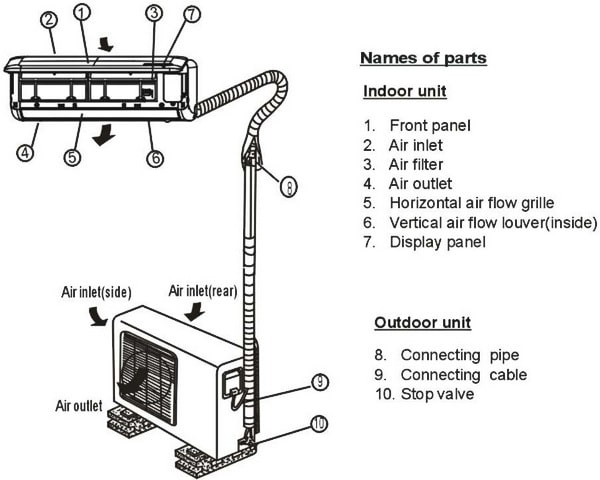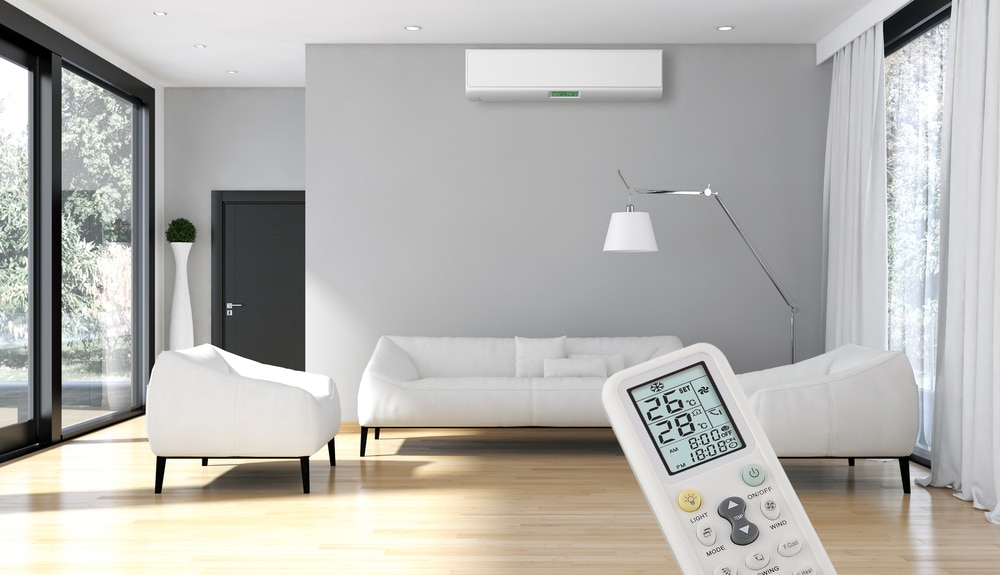Leonard Splaine Top 5 uses for a Ductless Mini-Split AC System

You may have seen the small, indoor electrical appliance installed high on walls in homes, restaurants or office buildings. But what do you really know about mini-split systems? A mini-split air conditioning system is an efficient, scalable way to add cooling air to specific rooms of a home or a building. Also known as ductless mini-split air conditioners, they consist of one or more wall, floor, or ceiling-mounted indoor units connected to an outdoor compressor. Ductless mini split air conditioners can be used in a variety of residential, commercial, and institutional facilities. They can also be an excellent option for small flats and room extensions when it is impractical to expand or build distribution ductwork for a central air conditioner.
They are a convenient alternative to central cooling systems. In this post, we’ll explain how these ductless mini split air conditioning systems work and the many benefits they provide.
How does a ductless mini split air conditioner work?
The air conditioning process, in its most basic form, comprises four simultaneous operations that take place both inside and outside the house.
- Hot air gets sucked in: The handling unit — which is what you see mounted on the walls of homes and businesses —takes in air from the room. The air then travels through a series of pipes to the condenser, which is outside.
- The energy in the hot air gets transferred to coils: When the humid, hot air reaches the condenser, which consists of many coils that contain coolant, the energy gets transferred to the coils. The result is that the coolant liquid gets turned into a gas.
- The coolant gas gets converted back into a liquid: The coolant gas then travels to the compressor section of the condenser unit, where it gets recycled in an electrical process that converts the gas back into a liquid.
- Cool air gets pumped out: The recently cooled air passes through a handler, where it gets ejected back into the room. With repeated cycles, the room’s temperature drops.
The Main Parts of an Air Conditioner

Now that we know how an air conditioner basically works and the main component of an air conditioner that controls its operation, Let’s look at some of the most significant benefits of ductless mini split cooling systems.
Benefits of Ductless Mini split Air conditioners

If you want to cool specific rooms with better efficiency and less clutter than window ACs and less complexity than central HVAC consider a mini-split system. A central air conditioner usually forces air through several rooms or the entire house often cooling rooms that aren’t even being used. “If you turn the water faucet on in the kitchen and every other water faucet turned on throughout the house…how efficient is that? That’s what central systems do,” says Mike Smith, senior marketing manager of Mitsubishi Electric. Here are the top benefits of having ductless mini split ac system:
1. Mini-Split Systems Are Highly Flexible Solutions:
Mini-split systems give flexibility for the cooling of specific rooms rather than just the entire house at once and are highly adaptable. While traditional cooling systems push cooled air through ducts, mini-splits directly deliver air to zones. A mini-split, such as the PerfectAire Model # 3PAMSH48-MZO5 can serve up to five zones from one condenser, each indoor air handler having its own thermostat, offering the ability to heat or cool spaces only when occupied, saving significant money and energy overtime.
Ductless mini-split systems also offer home and business owners a cost-effective way to replace inefficient window air conditioning units. Ductless mini-split systems can even be fit for buildings that currently use ducted forced-air systems. mini-splits provide homeowners with more options for interior design. You can hang them on your wall, suspend them from your ceiling or mount them flush into a drop ceiling. You can also buy models that stand on the floor.
2. Mini-split systems are much more energy efficient and can save you money:
One of the biggest reasons homeowners switch to ductless mini splits for their cooling needs is the overall cost savings and energy efficiency. Mini-splits are ductless, thus they eliminate the energy losses associated with ducted heating systems because the air just flows from the system directly into the room. According to the U.S. Department of Energy, Over 30% of the energy used by conventional central forced-air systems can be lost through ductwork, especially if the ducts go through attics or other unconditioned areas. Mini-splits with the Energy Star certification use 60% less electricity than standard electric heating and cooling systems. Due to this efficiency, ductless HVAC systems are significantly less expensive.
3. They Improve air quality
Generally, The air quality within buildings is frequently worse than the air quality outside. But, Homes with mini-split systems frequently have cleaner air than those with central heaters. Systems with ductwork gather molds, dust, pollen, and volatile organic compounds, which can impair the quality of the air in your home. Most homeowners neglect to clean and maintain their ducts because they are out of sight. Pollutants could still be present even after they’ve been cleaned professionally. With mini-splits, not only are there no ducts to collect these potentially harmful things, but they also feature multi-stage filtration designed to significantly reduce particulates such as dust, pollen, bacteria and allergens. Additionally, some electric mini-split units offer washable filters that you can maintain by routinely cleaning and replacing them. You and your family will be healthier as a result.
4. Mini-Split AC Systems Are Quick and Easy to Install:
Compared to other heating and cooling systems, mini-splits are often simpler to install. For instance, the conduit connecting the indoor and outdoor units often only requires a three-inch gap through the wall, and mini-split manufacturers typically have access to a wide range of conduit lengths. If necessary, the distance between the indoor and outdoor units might be as much as 50 feet. Using this installation method, you can install the outside unit on the side or in the back of the building to cool a room that is in the front of a house or building.
5. Better temperature control:
If you have multiple mini-split units installed in your home, you can control the temperature of each room, which is more energy-efficient than using a thermostat to control the temperature of your entire house. If the occupants of a home cannot agree on a single temperature, mini-splits are an ideal solution. Also, if you primarily use one room of your house, using a central heating or cooling system is wasteful.
Drawbacks of ductless mini split air conditioning systems
There are also a few potential downsides to owning a mini-split system.
1. They may not be aesthetically pleasing in some situations:
The inside unit might not complement your room’s overall color scheme or seem too “blocky” depending on the room. But because there are so many different designs for these systems, you should typically be able to find one that works.
2. They require regular maintenance:
Although mini-split maintenance is far less difficult than that for ducted systems, you’ll still need to change the filters once a month, or more frequently if you smoke or have pets. If you don’t clean your mini-split, it won’t be capable of handling the accumulating dirt, and you’ll need to hire a professional cleaner, which will cost you hundreds of dollars and perhaps shorten the life of your system.
3. There are more upfront costs:
Ductless mini-splits are significantly more expensive than equivalent baseboard or window units if you just use them in one room. Additionally, installing mini-splits in each room of your house in place of the present central heating and cooling system might cost two or three times as much as simply switching to a new ducted system. However, over time, you will save money thanks to decreasing energy costs. The climate in your area, how frequently you use your system, and the cost of electricity in your area will all affect how long it takes for your costs to be recovered.
Where can I use a ductless mini-split?
Ductless mini-split can be used in any situation especially in:
- Residential housing: newly constructed homes, multi-family dwellings, “non-ducted” housing, retro-fitted projects/ add-ons, apartment buildings
- Light Commercial: Warehouses, manufacturing facility offices, mechanical rooms, IT equipment rooms, data centers
- Institutional: hospitals, schools, assisted living facilities, government offices
Need an AC Maintenance or Repair Expert Near You?
Our contact us page makes it easy for you to get in touch with our our A+, licensed, and insured HVAC specialists. We can visit your home or business and inspect your system so that any problem areas can be identified. Our pricing and rates are fair and made with integrity. We have the experience to make repairs and get the cold air flowing again. Contact us today!
